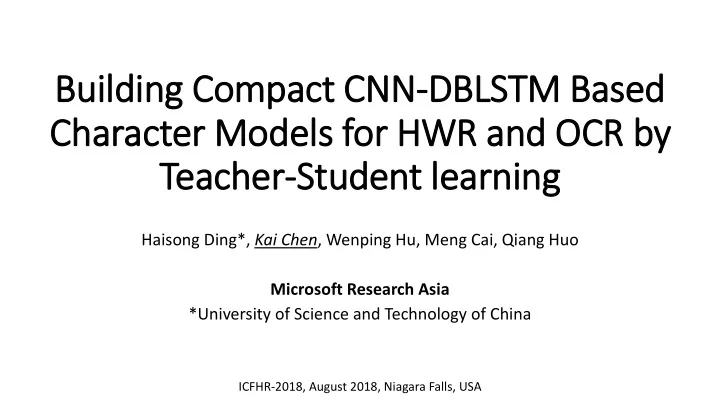

Building Compact CNN-DBLSTM Based Character Models ls for HWR and OCR by Teacher-Student le learning Haisong Ding*, Kai Chen , Wenping Hu, Meng Cai, Qiang Huo Microsoft Research Asia *University of Science and Technology of China ICFHR-2018, August 2018, Niagara Falls, USA
Outline • System Overview • CNN Compression Method Review • Teacher-Student Learning • Future Work
System Overview *IP: Inner-Product Layer
System Overview Latency Model Param. Model (ms/line) % # % Conv3x3 197.43 97.68 7.64M 92.54 Conv1x1 0.089 0.044 8.0e-3M 0.097 CNN ReLU 1.25 0.62 \ \ MaxPooling 0.51 0.25 \ \ DBLSTM 2.84 1.41 0.62M 7.48 Total 202.12 100 8.26M 100 *elapsed time is evaluated on 1 Core i7-6700 CPU core
Ways to Compress CNN • Pruning • Quantization • Teacher-Student Learning • Tensor Decomposition
Teacher-Student Learning Model construction pipeline: • Train a VGG-DBLSTM with CTC criterion from scratch as teacher model • Distill a DarkNet-DBLSTM using teacher-student learning with specified criterion: Criterion Distillation Position Metric Softmax-CE Outputs of Softmax layer cross entropy Outputs of IP layer IP-L2 LSTM-L2 Outputs of last LSTM layer L2 distance Feedforward inputs of 1 st LSTM layer CNN-MAH CNN-L2 Outputs of last conv layer During distillation, keep LSTM and IP layers fixed. • Fine-tune DarkNet-DBLSTM with CTC criterion to get final model.
Loss Functions (1/2)
Loss Functions (2/2)
Why DarkNet? Comparison of VGG-DBLSTM and DarkNet-DBLSTM in terms of model parameters, computation cost, and runtime latency Model Params GLOPs Runtime # Cr # Sr Latency Speedup VGG-DBLSTM 8.26M 1.00 11.81 1.00 202.12 1.00 DarkNet-DBLSTM 1.47M 5.62 0.69 17.04 14.19 14.24 Cr: compression ratio Sr: theoretical speedup ratio
Experimental Setup – HWR Task • Training set: • 283k handwriting text line images extracted from whiteboard and handwritten note images • Validation set: • 4k text line images • Test set: • E2E: 4,028 text line images extracted from 288 whiteboard and handwritten note images • IAM: 1,861 text line images extracted from IAM Handwriting English Sentence dataset
Experimental Results – HWR Task IAM E2E Model Loss Function CER WER CER WER VGG-DBLSTM CTC 3.3 8.2 4.1 13.4 DarkNet-DBLSTM CTC 3.8 9.0 4.6 15.1 CNN-L2 3.5 8.7 4.2 13.8 CNN-MAH 3.5 8.5 4.2 13.6 LSTM-L2 3.5 8.6 4.2 13.7 IP-L2 3.7 8.7 4.3 13.9 DarkNet-DBLSTM (teacher-student learning) Softmax- CE (Ƭ=1) 3.6 8.8 4.4 14.2 Softmax- CE (Ƭ=2) 3.7 9.0 4.4 14.1 Softmax- CE (Ƭ=5) 3.7 9.0 4.5 14.4 Softmax- CE (Ƭ=10) 3.8 9.1 4.5 14.5 *CER: Character Error Rate; WER: Word Error Rate
Analysis Loss function values of student models trained with different teacher-student learning criteria on HWR task Model Loss function ℒ (Softmax−CE) ℒ (IP−L2) ℒ (LSTM−L2) ℒ (CNN−MAH) ℒ (CNN−L2) ℒ (CTC) Softmax-CE 0.166 0.271 2.35e-3 19.583 0.101 10.686 IP-L2 0.196 0.0986 7.95e-4 0.455 4.14e-3 9.035 LSTM-L2 0.180 0.0763 5.96e-4 0.371 3.85e-3 8.696 CNN-MAH 0.183 0.0838 6.66e-4 0.232 2.18e-3 8.971 CNN-L2 0.201 0.0854 6.69e-4 0.260 2.26e-3 9.059
Comparison with Tucker Decomposition • Tucker decomposition Decompose Conv3x3 to Conv1x1-Conv3x3-Conv1x1 to compress and accelerate CNN simultaneously Teacher-student learning vs Tucker decomposition in terms of recognition accuracy (%), model parameters, GFLOPs and runtime latency Model IAM E2E Params GFlops Runtime CER WER CER WER # Cr # Sr Latency Speedup VGG-DBLSTM 3.3 8.2 4.1 13.4 8.26M 1.00 11.81 1.00 202.12 1.00 DarkNet-DBLSTM 3.5 8.5 4.2 13.6 1.47M 5.62 0.69 17.04 14.19 14.24 VGG-TK-DBLSTM-v1 3.5 8.6 4.3 14.1 0.99M 8.34 0.74 15.92 26.96 7.50 VGG-TK-DBLSTM-v2 3.4 8.5 4.2 13.7 1.13M 7.31 1.05 11.17 32.46 6.23 VGG-TK-DBLSTM-v3 3.4 8.4 4.2 13.5 1.79M 4.61 2.35 5.03 60.37 3.35 * We have optimized runtime implementation after paper submission.
Experimental Setup – OCR Task • Training Set • 1.06M printed text lines extracted from Open Image dataset and Microsoft street view images • Validation Set • 131K printed text lines • Test Sets • G-test: 55,258 text lines extracted from Open Image dataset • S-test: 44,823 text lines extracted from street view dataset • IC13: 1,094 text lines from ICDAR-2013 robust reading competition set • Training configuration • Parallel training with Blockwise Model Update Filtering (BMUF) method on 8 GPU cards
Experimental Results – OCR Task CER(%) and WER(%) of DarkNet-DBLSTM student model on OCR task G-test S-test IC13-test Model CER WER CER WER CER WER VGG-DBLSTM 1.8 6.1 0.8 3.8 4.0 11.1 DarkNet-DBLSTM 2.2 7.1 1.1 4.7 4.4 13.2 (from scratch) DarkNet-DBLSTM 1.8 6.2 0.8 3.8 4.0 11.4 (CNN-MAH)
Conclusion • Teacher-Student learning unblocks the deployment of CNN- DBLSTM based character model. • Guidance of LSTM layers helps to distill a better student model.
Future Work • Compressing LSTM layers • Designing more compact student models
Thanks!
Recommend
More recommend